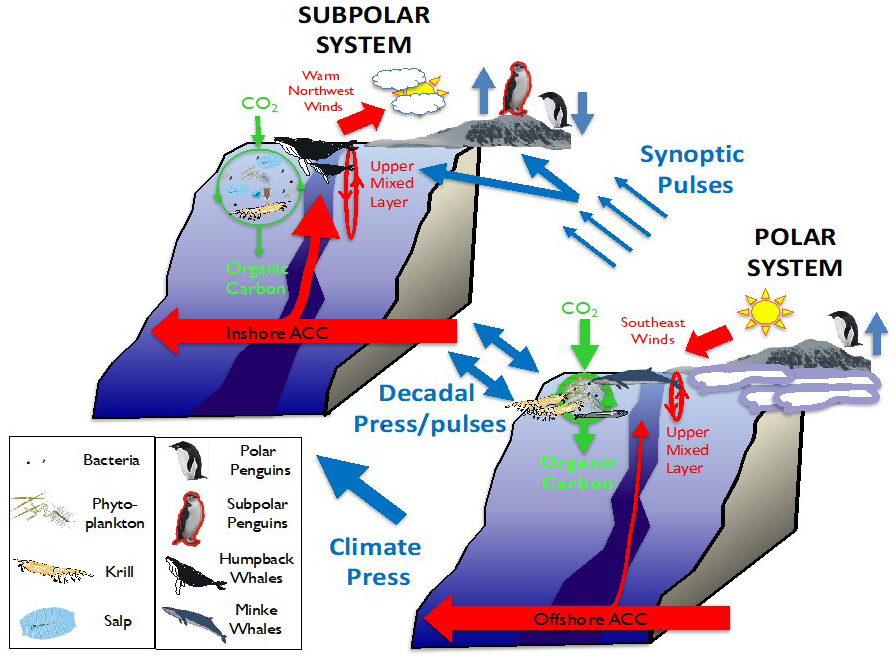LTER: Ecological Response and Resilience to “Press-Pulse” Disturbances and a Recent Decadal Reversal in Sea Ice Trends Along the West Antarctic Peninsula
Palmer Station Antarctica (LTER) is an interdisciplinary polar marine research program established in 1990 as part of a national network of long-term ecological research sites created by the United States National Science Foundation (NSF). Being one of three U.S. research station located in Antarctica, Palmer LTER focuses on the region along the western side of the Antarctic Peninsula (WAP). https://pal.lternet.edu/about
Seasonal sea ice-influenced marine ecosystems at both poles are regions of high productivity concentrated in space and time by local, regional, and remote physical forcing. These polar ecosystems are among the most rapidly changing on Earth. The PALmer (PAL) LTER seeks to build on three decades of long-term research along the western side of the Antarctic Peninsula (WAP) to gain new mechanistic and predictive understanding of ecosystem changes in response to disturbances spanning long-term, decadal, and higher-frequency “pulse” changes driven by a range of processes, including natural climate variability, long-term climate warming, resiliency/recovery in the face of press versus pulse forcing, transformed spatial landscapes, and food-web alterations. We will contribute to fundamental understanding of population and biogeochemical responses for a marine ecosystem experiencing profound change.
We will continue to address the influence of major natural climate modes (e.g., El Niño Southern Oscillation, Southern Annular Mode) that modulate variations in sea ice, weather, and oceanographic conditions to drive changes in ecosystem structure and function. Our sampling and analyses cover multiple time scales–from diel, seasonal, interannual, to decadal intervals, and space scales–from hemispheric to global scale investigated by remote sensing, the regional scale covered by an annual summer oceanographic cruise along the WAP, and the local scale accessed by daily to biweekly small boat sampling at Palmer Station. Autonomous vehicles, floats, moorings, and modeling enable us to expand and bridge time and space scales not covered by vessel-based sampling providing a seasonal to annual context. These observations are complemented with process studies that include manipulative experiments conducted on our annual research cruise and at Palmer Station.
Beginning in 2020, the Van Mooy Laboratory will bring the study of energy-bearing lipid and carbohydrate molecules to PAL-LTER project. Given emerging observations that light availability is a fundamental feature structuring productive coastal systems and export of carbon, understanding energy flow through the ecosystem is critically important. Phytoplankton have evolved methods of storing chemical energy (e.g., lipids, carbohydrates). Chief among these, particularly for eukaryotic phytoplankton, is the synthesis of energy storage lipids, such as triacylglycerols (TAGs). Preliminary findings show this phenomenon is significant across the WAP:
- the concentration of TAGs in phytoplankton are 90% higher in light incubations vs. those in the dark;
- TAG concentrations in the water column were 6X higher at 5 m depth than at 30 m; and
- euphotic zone TAG inventories doubled between mid- and late-November, coincident with the onset of the bloom.
We posit that temporal and spatial gradients in TAGs and other energy storage molecules in phytoplankton can influence the abundance, behavior, and energy density of krill, and thereby, other organisms in the food web.
Differences in prey quality (i.e., lipid and caloric content) affect the ability of predators to meet their energetic demands, and have implications for key life history stages, such as penguin chick fledging and recruitment success. Quality of penguin and whale prey also differs by taxa, with fish (myctophids) having the highest prey quality in terms of lipid content and energy density, followed by different krill species. These observations suggest that prey quality may also be affected by climate migration, which we will examine in PAL-6 using new lipidomic approaches.
Collaborators
- Oscar Schofield (Rutgers University, Lead PI)
- Janis McDonnell (Rutgers University, co-PI)
- Debbie Steinberg (Virginia Institute of Marine Sciences, Lead PI)
- Scott Doney (University of Virginia, co-PI)
- Ari Friedlaender (University of California Santa Cruz, co-PI)
- Megan Cimino (University of California Santa Cruz, co-PI)
- Carlos Moffat (University of Delaware, co-PI)
- Sharon Stammerjohn (University of Colorado-Boulder; co-PI).

